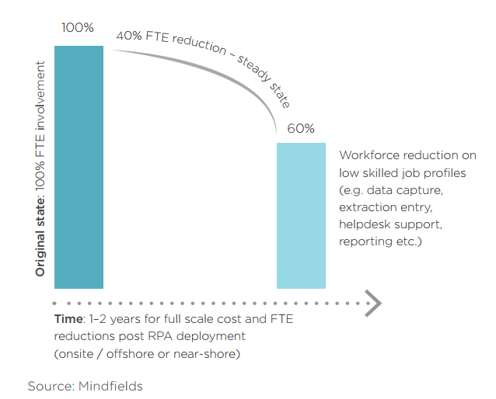There has been a steady increase in RPA-enabled integrated IT/ BPO engagements in the last year, some at proof of concept stage. Automation capability is now being adopted across all regions, and expanding from manufacturing into the services sectors. However, automation deployment has been limited by high set-up costs and lower labor costs, especially in off-shore locations.The market is still nascent, but client organizations are expecting their service providers to embed their RPA capabilities , a move which will reduce costs by around 30- 50% and improve the accuracy of rule- based processes and tasks. IT/BPO service providers are trying to fully gauge the impact of embedding RPA solutions into their service offering. We expect 2018 to be the year when RPA becomes a buzzword and even a game-changer for service providers. The potential for significant process efficiencies, cost improvements and flexibility in managing projects will be tremendous but the scale and complexity of implementations is currently limited.
Current limitations in RPA technology
A number of enhancements will help drive adoption, but RPA technology still needs to undergo further R&D to help overcome some current limitations:
Capturing inputs from diverse formats
Deploying robots to read through different formats remains a challenge. Robot applications cannot, for example, read or capture data from scanned images including handwritten content without using OCR technology. Advances in self-learning and artificial intelligence, combined with integrating current RPA capabilities with more sophisticated input devices such as OCR technologies, will open up a significantly broader set of processes. We expect this will make the RPA business case look more attractive and open up to areas which use scanned images, including insurances claims and invoices.
Processing unstructured email content
Free format email communications between supervisors and process managers with agents have a high degree of unstructured data. This makes it difficult for robotic applications to capture or comprehend information without human intervention. Advances in AI, self-learning and analytics capabilities will make it easier to integrate RPA into such systems and automate processes reliant on such unstructured data.
Frequent changes in business rules and operating procedures
Currently, the effectiveness of RPA technology diminishes when the frequency of changes in business rules varies on an ongoing basis. RPA platforms perform at optimal levels when standard operating procedures are well defined and undergo minimal changes. In processes where the rules keep changing, the level of re-work on re-programming robots to incorporate the changes goes up. This means additional investment in coding, testing the changes and re-deploying the robots in live environments. This can impact productivity and efficiency, and require frequent human intervention to manage exceptions and reprogram the robots.
Most of these issues will be addressed over time as automation software vendors continue to innovate, improvise and incorporate new functionalities and features into subsequent generations of their RPA platforms.
FACTORS IMPEDING RAPID ADOPTION OF RPA
Service Providers, some in conjunction with RPA software providers, are working jointly to address the current limitations of existing RPA technology, but there are other factors impeding more rapid adoption:
- Industry standards are still being developed. RPA has only recently emerged as a recognized offering and well-defined industry standards are yet to be formalized.
- RPA initiatives are being adopted in pockets, typically among early adopter organizations that can see the benefits in their environments even while industry standards are still being developed.
- Many enterprise buyers are cautiously waiting on the sidelines, keen to develop a deeper understanding of this rapidly emerging area, how it applies to their business environment, and how the business case stacks up before they take the plunge.
- The current wave of RPA is only applicable to a narrow scope of services, namely, simple rule-based processes, typically with a high level of human involvement. Much of this can be replaced by RPA and offer a relatively quick payback.
- Existing multi-year BPO contracts which are primarily structured on a labor arbitrage model may act as blockers for RPA implementation until contracts near expiry or are due for renewal.
- Some service providers are reluctant to push RPA too hard at this stage for fear of cannibalizing existing revenue streams.
RPA SERVICE PROVIDERS LANDSCAPE
[EXTRACT] Outsourcing service providers are interested in replicating the concept of RPA on multiple project engagements across verticals. The scale and frequency is gradually increasing which has clearly made the early adopters of RPA more confident in spreading their army of robot applications across other functions and processes.
This is directly driving their non-linear revenue growth opportunities. To substantiate this, around 43% of the service providers who participated in our study have witnessed FTE reductions of over 20% as a result of RPA.

Now, under such circumstances, backed up with increasing pressures of wage inflation and currency fluctuations, BPOs are banking on disruptive technologies that enable them to revamp their existing service delivery models to expand their non-linear growth plans. An RPA enabled solution may not incorporate an FTE-based assumption, but rather go immediately to a transaction-based model. This then opens up outcome-based pricing opportunities on other complex project engagements. This is where RPA has got the entire market excited, especially with the larger Tier I service providers which have global delivery capabilities worldwide.
Topic: Robotic Process Automation, Blog


